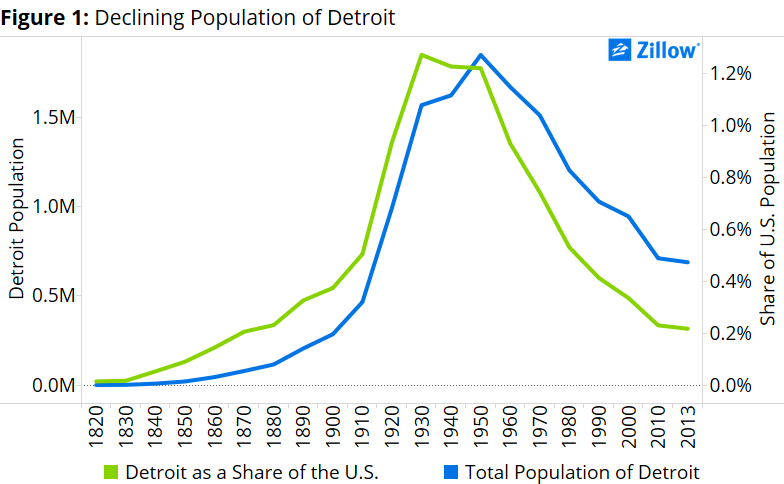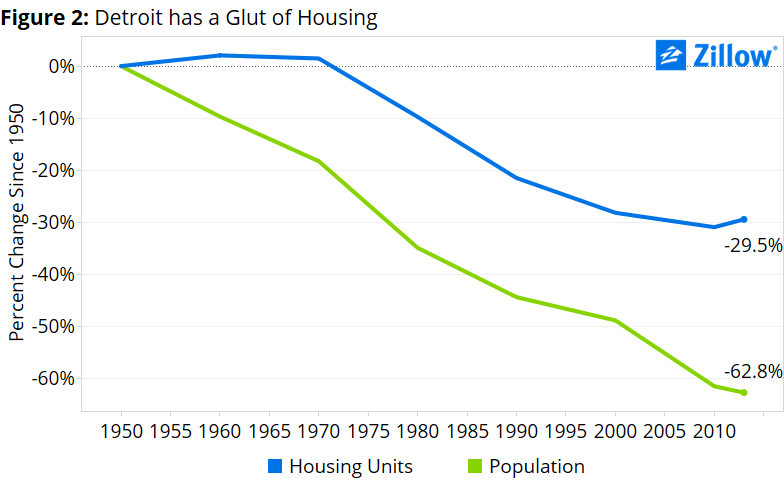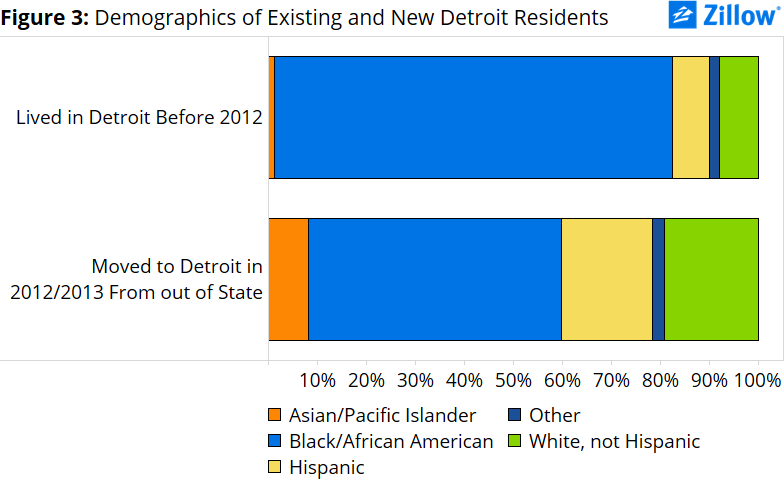On Thursday, May 7, Zillow will visit Detroit as part of its Housing Roadmap to 2016 series of events and roundtables.
The housing issues Detroit faces are both familiar to dozens of struggling cities nationwide, and utterly unique to the Motor City. Leading up to our May 7 visit, we will be posting a series of research pieces diving in to these complex issues. We hope to shed light on the challenges, but also to illuminate what makes the city so unique and glean potential lessons from which other struggling cities may be able to learn.
Below is the third in this series. Our prior Detroit-specific research can be found here.
It’s no secret that Detroit’s population is shrinking rapidly. But as residents leave, they also leave behind rapidly aging homes that may – or may not – be attractive to those few residents deciding to move in.
 Detroit’s population boomed during the first half of the twentieth century, peaking at 1.8 million in 1950. Since then, the city’s population has steadily declined, falling to 689,000 in 2013 – the lowest number of residents since 1910, the eve of the automobile manufacturing boom that revolutionized Detroit’s economy (figure 1).[1]
Detroit’s population boomed during the first half of the twentieth century, peaking at 1.8 million in 1950. Since then, the city’s population has steadily declined, falling to 689,000 in 2013 – the lowest number of residents since 1910, the eve of the automobile manufacturing boom that revolutionized Detroit’s economy (figure 1).[1]
This decline in urban population is not unique to Detroit – cities nationwide experienced contracting populations as residents flocked to the suburbs during the early Baby Boom years, and later with the urban decay of the 1970s and 1980s. But since 1950, Detroit has also lost ground in relative terms.
Compared to the overall U.S. population, Detroit has gradually become less prominent. In 1950, 1.22 percent of the U.S. population – about one in every 82 Americans – lived in the city of Detroit. By 2013, 0.22 percent of the U.S. population – roughly one in every 450 Americans – lived in the city of Detroit, the lowest share since 1870.
As Detroit’s population declined, so too did its housing stock, though at a much slower rate. Between 1950 and 2013, Detroit’s population fell by more than 60 percent. But the number of homes within the city fell by only 30 percent (figure 2).[2] In other words, the number of people living in Detroit has declined twice as quickly as the number of homes within city limits. Detroit lost about 250,000 residents between 2000 and 2013, while the number of existing homes fell by just 6,600, according to Census data.
 Populations shift much more rapidly than structures – houses cannot just get up and move to the suburbs. And the legacy of Detroit’s early-twentieth-century population boom is still visible in the city’s now aging housing stock. Almost all (94 percent) of Detroit’s existing housing stock was built during the boom years between 1910 and 1960, according to a Zillow analysis of public records data. Currently, the city has more homes built before 1910 than homes built since 1960.
Populations shift much more rapidly than structures – houses cannot just get up and move to the suburbs. And the legacy of Detroit’s early-twentieth-century population boom is still visible in the city’s now aging housing stock. Almost all (94 percent) of Detroit’s existing housing stock was built during the boom years between 1910 and 1960, according to a Zillow analysis of public records data. Currently, the city has more homes built before 1910 than homes built since 1960.
Still, even as hundreds of thousands of residents have left Detroit, a small number of people are moving in, potentially soaking up some of that excess housing supply and gradually changing the racial composition of the city (however slightly). Roughly 10,000 new residents have moved to Detroit annually from out of state in recent years.[3] Almost half (46 percent) of these recent migrants to Detroit identify as white, Hispanic or Asian, compared to just 17 percent of those living in Detroit before 2011 (figure 3).
 Detroit’s population is changing, largely driven by a 60-year-old urban flight trend that is, in some respects, not so different from dynamics confronting cities across the United States. On a much smaller scale, it is also driven by new and different population inflows.
Detroit’s population is changing, largely driven by a 60-year-old urban flight trend that is, in some respects, not so different from dynamics confronting cities across the United States. On a much smaller scale, it is also driven by new and different population inflows.
In either case, the city’s supply of housing has been slow to respond.
[1] Earliest to 1990: Campbell Gibson and Kay Jung, Historical Census Statistics On Population Totals By Race, 1790 to 1990, and By Hispanic Origin, 1970 to 1990, For Large Cities And Other Urban Places in The United States, U.S. Census Bureau, Population Division Working Paper No. 76, February 2005. 2000 and later: U.S. Census Bureau, Decennial Census 2000, American Community Survey 2010 and American Community Survey 2013.
[2] Earliest to 1990: U.S. Census Bureau, Selected Historical Decennial Census Population and Housing Counts, Table 38: 1990 Population and Housing Counts: United States (including Urban and Rural Population, and Population Rank of Incorporated Places of 100,000 Population or More). 2000 and later: U.S. Census Bureau, Decennial Census 2000, American Community Survey 2010 and American Community Survey 2013.
[3] Zillow analysis of a pooled sample of data from the U.S. Census Bureau’s 2012 and 2013 American Community Survey, made available by the University of Minnesota, IPUMS-USA. Data sample sizes are small and should be interpreted with caution.